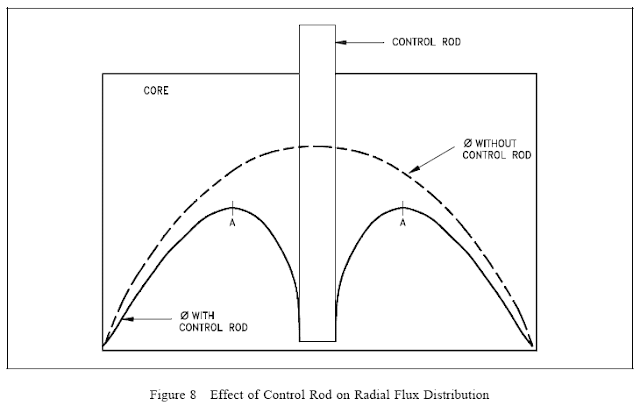Background:
In a Pressurized Water Reactor (PWR), the control rods are completely removed from the core after the reactor is up to full power, and dilute Boric Acid (a strong neutron poison) is carefully added to control reactivity.
The purpose of this process is to achieve a flatter neutron flux profile throughout the core.
A flat neutron flux is desirable for a couple of reasons: It helps to even out fuel burnup and it helps to reduce hot and cold coolant channels. When control rods are partially inserted into an operating reactor core, neutron flux is depressed near them, since they absorb neutrons. Therefore fewer fissions occur near the control rods. This localized reduction of fission causes uneven fuel burn and creates cold zones due to reduced fission near the rods. For a given power output, other sections of the reactor core away from the control rods must now run hotter to compensate.
Below, a side-view of a reactor core. The solid line indicates neutron population in this reactor at steady-state power, with a control rod partially inserted to control reactor power. Because there are very few neutrons in the area adjacent to the control rod, for a given power level, other areas of the core have to produce more fissions. The spots on the solid line marked "A" are those places where we might see excessive fissions, overheating, and possible fuel element failures.
The dashed line indicates neutron population with the control rod removed (which is possible if you add Boric Acid as a virtual liquid control rod). As you can see, neutron population is more consistent throughout the reactor, and therefore there won't be any excessive localized fission and heating, as you see at the points marked "A"
With borated primary coolant, neutrons are depressed equally throughout the core, and so power generation is more evenly distributed, and the reactor can be run closer to its thermal limit, because there is no need to account for hot and cold zones due to tilting of the neutron flux.
However you would hope that there is a better way to keep a flat neutron flux profile throughout a reactor core than using very hot diluted boric acid in the primary coolant loop.
As mentioned above, the primary coolant in these PWR reactors contains Boric Acid, which is a mild acid. For this reason, the piping, pumps, valves, etc are all made of high chrome steel (stainless steel).
The reactor vessel and closure head, however, are not. Due to their size, it is impractical to make the entire thing from stainless steel. Instead, the reactor vessel and head are made from carbon steel, and their interior is clad with a sheet of 3/8" thick stainless steel. In this way, the carbon steel, which is not resistant to acids, is protected from contact with the Boric Acid in the primary coolant.
The Event:
In 2002, Davis-Besse nuclear power plant in Ohio discovered they had a very minor primary coolant leak. The coolant was leaking out along a penetration in the reactor vessel head, where a Control Rod Drive Mechanism (CRDM) was mounted. The CRDM is what pulls the control rods out of the core and allows the reactor to start and shut down. The coolant leak was so minor that it hadn't been noticed - in a million gallon system, a minor leak can go undetected almost forever. Any water leaking from the primary coolant would also be quite hot and would flash to steam immediately, so no water puddling would occur.
Davis-Besse had a tiny coolant leak, however. One which they were unaware of. In 2002 the plant shut down for a refueling outage, and performed an inspection underneath the insulation on the reactor vessel head. This was done after other plants of the same design had uncovered minor leakage. They found a little problem...
At the time it was discovered, the acid had eaten away a hole the size of a football completely through the reactor vessel head in the area of the leaking CRDM penetration. The only thing that was holding the 2500 psig primary coolant in place was 3/8" of stainless steel cladding, which was bulging outwards from the pressure.
Below is a picture of a Babcock & Wilcox design PWR primary coolant loop, with the reactor vessel head highlighted.
Below are images of the hole in the reactor vessel head.
The photo below gives you an idea how thick engineers designed the reactor vessel head to keep 2500 psig of primary coolant in place. It's astonishing (and wonderful) that thin piece of 3/8" of stainless steel was able to keep the coolant from blasting out.
This would not have been merely a primary coolant leak. This would have been a major accident. Here are some of the potential consequences of such a massive leak, had the cladding ruptured:
- A massive steam/water jet would have blasted out of this hole, certainly damaging this control rod, but possibly adjacent ones also. Could the ability of the reactor to shut down been compromised?
- The steam/water blast probably would have ripped tons of insulation loose. This would have fouled the intake of the emergency water re-injection system, which takes suction from the floor of the containment building.
- Major coolant leak accidents are typically modeled for weaker points in the primary coolant system - pumps, steam generators, drain lines, etc. These are equipped with remote-operated valves to isolate these leaks from the reactor core. This leak was was directly above the reactor core, and not isolable from it. Continuous water injection directly into the core would be required for several months to prevent decay heat from melting it.
- It is very likely that with the reactor fill system compromised due to ingesting insulation, and an unisolable leak right above the fuel, that core damage would have occurred.






1 comment:
Petrifying.
Post a Comment